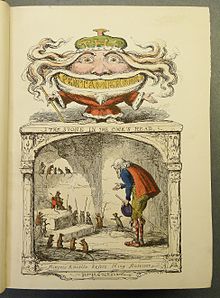The rooster stone

The Rooster Stone ( Neapolitan original: La petra de lo gallo ) is a fairy tale ( AaTh 560). It is in Giambattista Basile 's Pentameron collection as the first story of the fourth day (IV, 1). Felix Liebrecht translated The Hahnenstein .
content
Aniello sells the rooster, his last possessions to two wizards. Then he listens to them that the stone in his head fulfills every wish, and slaughters himself. He wishes himself young again, gets a castle and the king's daughter. The magicians, however, turn a dancing doll on his daughter and thus come to the ring. The aged and impoverished again migrates to the kingdom of mice, two of whom once overheard in the pub that one of the thieves never takes off the ring. When he arrives at this one, one gnaws his finger in his sleep, so he puts it down and the other carries it away. Aniello transforms the thieves into donkeys, on which he brings cheese to the mice. Then he overthrows the donkey and is welcomed by the king with pleasure.
Remarks
See Basile V, 1 Die Gans . Rudolf Schenda notes that Pliny the Elder already mentions stones in the heart of roosters, which were thought to have magical powers. The material can also be found in Lorenzo Lippi's epic Malmantile racquistato (Canto IV). Clemens Brentano edited the fairy tale as The fairy tale of Gockel and Hinkel in Italian fairy tales . Kletke translated it as Der Hahnenstein in Märchensaal (No. 1). Cirese / Serafini know modern variants. See Grimm nos. 60 , 85 , 122 , 104a . Walter Scherf explains the initial mistrust of the mice with an oral tradition that the grateful cat brings back the stone by catching a mouse, the dance doll with possible Byzantine borrowing, as in Gonzenbach's From the Golden Lion in Sicilian Fairy Tales (No. 68), 1870.
literature
- Giambattista Basile: The fairy tale of fairy tales. The pentameron. Edited by Rudolf Schenda. CH Beck, Munich 2000, ISBN 3-406-46764-4 , pp. 304-309, 551, 603 (based on the Neapolitan text from 1634/36, completely and newly translated).
Web links
- Gutenberg-DE: The Hahnenstein in German translation (probably after Felix Liebrecht)
- Märchenlexikon.de on AaTh 560
- Märchenatlas.de on The Hahnenstein
- The Cock's Stone in verse by Laura Bobrow (English)
Individual evidence
- ^ Giambattista Basile: The fairy tale of fairy tales. The pentameron. Edited by Rudolf Schenda. CH Beck, Munich 2000, ISBN 3-406-46764-4 , p. 603 (based on the Neapolitan text of 1634/36, completely and newly translated).
- ↑ Walter Scherf: The fairy tale dictionary. Volume 1. CH Beck, Munich 1995, ISBN 978-3-406-51995-6 , pp. 558-559.